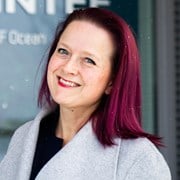The goal of the GoJelly project is to transform two major environmental threats into new possibilities. We will develop, test and promote solutions for utilising the increase in jellyfish population throughout several coastal areas as a resource for new marine products, while at the same time using the waste material from this product (jellyfish slime) as a natural capturing mechanism for microplastic in municipal water treatment plants. In this way, the project addresses two problems in one, by removing destructive microplastic pollution and combating jellyfish overpopulation, while at the same time opening for new possibilities for business development from marine raw materials in coastal areas.

GOJELLY EXAMINES THE MANY OPPORTUNITIES IN THE INTERSECTION OF JELLYFISH AND MICROPLASTIC
It's no secret that microplastic in the marine environment is an increasing problem. 950 million kg of microplastic is released into our oceans yearly, and Norwegians alone release 8 million kg of this. Of this Norwegian amount, 80,000 kg of microplastic come from cosmetics alone, that get released into the ocean through municipal water treatment systems. The full effect that this pollution has on our marine ecosystem, as well as the marine food chain (and us as consumers of seafood) is still unknown.
At the same time, coastal societies and fishers across the world are experiencing that beaches and fishing nets are being filled up with jellyfish, which negatively impacts their business. The jellyfish follow the currents, and it is estimated that the increase in the jellyfish population is likely due to warmer water as a result of climate change. Nonetheless, there is currently no widespread industry in Europe that is prepared to start utilising this increasing biomass.
THE CONTEXT
GoJelly will change this negative trend by harvesting jellyfish in three oceanic areas, and developing, testing and demonstrating a microplastic jelly filter as well as other products (cosmetics, food, fertiliser and feed) from the jellyfish. We will also test jellyfish breeding in order to cover what we believe will be a need for a stable supply of jellyfish in the future, when product development stabilises and demand increases. GoJelly will also look at local, national and global management regimines for microplastic pollution, and develop an interactive game tailored to the problem at hand.
FINANCING AND PARTNERS
GoJelly is financed through Horizon2020. The project has 16 partners and is coordinated by GEOMAR in Germany. SINTEF Ocean coordinates Work Package 7: Socioecological system and games, and is also heavily involved in work packages relating to modelling of the increase in jellyfish populations, processing of jellyfish and product development, as well as testing of jellyfish slime for microplastic capture in water treatment plants.
PLAY THE GOJELLY GAME!
The GoJelly project has created a digital, socio-ecological strategy game that is open for all to play and participate in the GoJelly research.
Read more about participation in the research project here, and access the game here.

